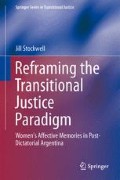Abstract
When I interviewed Maria in 2009, she had just given her oral testimony at the Tribunal Oral Federal 6, a court located in the Argentine capital of Buenos Aires. Her testimony described the torture she suffered at Campo de Mayo, a clandestine detention centre in Buenos Aires during the 1976–1983 military dictatorship. An eyewitness to the military’s human rights abuses, Maria told me about the risks she takes and the fear she has for the safety of her children by speaking publicly about her experiences. Pinned to Maria’s shirt is a badge showing a photo of her partner, Guillermo Oscar Sigalli, who was a fourth-year architecture student before he was disappeared in 1978.
Access this chapter
Tax calculation will be finalised at checkout
Purchases are for personal use only
Notes
- 1.
Coined by the military as a way of denying the kidnap, torture and murder of its citizens, the word desaparecer, ”to disappear”, began to be used as a transitive verb in the Argentine language from the time of the military coup, 24 March 1976 (Feitlowitz 1998). Those who were disappeared by the military are referred to in Argentina as los desaparecidos. The majority of these individuals were abducted by the security forces and taken to clandestine detention centres, where they were tortured and later murdered (CONADEP 1986).
- 2.
The total number of disappeared is contested (see Brysk 1994). While the official Comisión Nacional sobre la Desaparición de Personas (CONADEP) (National Commission on the Disappearance of Persons) report documented 8,960 cases of disappeared individuals, the figure is likely to be greater due to forces that prevented individuals from testifying to the CONADEP taskforce, including aggravated threats made to witnesses and fear of reprisals for offering information (CONADEP 1986). Argentina’s Under Secretariat for Human Rights has confirmed about 3,000 new cases, bringing the official number up to 12,000 (Barahona de Brito 2001). Thirty thousand is considered an emblematic figure used by the majority of Argentine human rights organisations. The vast majority of disappearances occurred from 1976 to 1977 (CONADEP 1986).
- 3.
As of August 2013, 109 of an estimated 500 children taken from their mothers after birth while held in one of the military’s clandestine detention centres have been recovered with the assistance of Las Abuelas de la Plaza de Mayo (Grandmothers of the Plaza de Mayo) (www.abuelas.org).
- 4.
By August 2013, a total of 381 sets of criminal proceedings in relation to state terrorism were in process, in which 2071 armed forces personnel, security officials and civilians faced charges linked with state terrorism during the military dictatorship 1976–1983. Of these, 405 have been sentenced, 370 have been condemned, 35 have received pardons (www.cels.org.ar).
- 5.
A number of such terms have emerged within the field of transitional justice to describe strategies and initiatives used to achieve justice and to build trust among adversarial communities. Discourse around national reconciliation has more recently relied upon a therapeutic model, which seeks to heal wounds in connection with past violence and focuses on recognition of the victims of violence to recover sovereignty (Humphrey 2005).
- 6.
Affect can be used as a broad term to refer to emotions, feelings, and affects (Forgas 2000). Though they are often used interchangeably, it is important to define the difference between the three. Feelings are personal and biographical, emotions are social and affects are pre-personal. Displays of emotion can be genuine or feigned; when we relay our emotions publicly, they may be an expression of our internal state or they may be contrived in order to fulfil social expectations. Meanwhile, affects are more abstract than emotions because they cannot always be fully realised in language. They are non-conscious and unformed, and refer to the body’s way of preparing itself for action in a given circumstance with an added dimension of intensity (Shouse 2005). Affects are linked to autonomic responses, which can expand or diminish the body’s capacity to act or engage with others (Clough 2007).
- 7.
Memoria Abierta, based in Buenos Aires, is a coordinated group of human rights organisations that works to raise social awareness and knowledge about the years of the military dictatorship 1976–1983 in Argentina. It has established an audiovisual archive that houses some 650 testimonials and a photographic archive that contains more than 16,000 images (www.memoriaabierta.org.ar).
- 8.
As will be further explored in the following chapter, the Due Obedience Law enacted under the Alfonsín administration had a legal loophole, which excluded from its purview those who had assisted or planned the abduction of children of the desaparecidos. In a landmark case in 1998, Generals Videla, Massera, Bignone and Nicolaides, together with five lower ranking officers, were charged and jailed for the illegal abduction and adoption of children in seven clandestine centres (Barahona de Brito 2001).
- 9.
The organisation, though concerned with issues of historical justice , is perceived by the Argentine human rights movement as having an active political agenda.
Author information
Authors and Affiliations
Corresponding author
Rights and permissions
Copyright information
© 2014 Springer International Publishing Switzerland
About this chapter
Cite this chapter
Stockwell, J. (2014). Introduction. In: Reframing the Transitional Justice Paradigm. Springer Series in Transitional Justice, vol 10. Springer, Cham. https://doi.org/10.1007/978-3-319-03853-7_1
Download citation
DOI: https://doi.org/10.1007/978-3-319-03853-7_1
Published:
Publisher Name: Springer, Cham
Print ISBN: 978-3-319-03852-0
Online ISBN: 978-3-319-03853-7
eBook Packages: Behavioral ScienceBehavioral Science and Psychology (R0)

